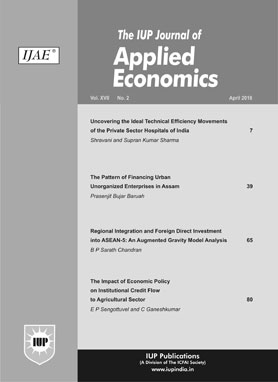
April' 23
The IUP Journal of Applied Economics
Dr C R Rao: The Pride of India
Dr Calyampudi Radhakrishna Rao, the Indiaborn
American mathematician and
statistician, has been awarded the 2023
International Prize in Statistics-equivalent
of the Nobel Prize-for the monumental
work done by him 75 years ago that
revolutionized statistical thinking. This award
will be presented to 102-year-old Dr Rao at
the International Statistical Institute World
Statistics Congress in Ottawa, Canada, in
July 2023.
Dr Rao reported this remarkable work in
a paper, "Information and
Accuracy Attainable in the
Estimation of Statistical
Parameters".1 The origin of
this paper is equally
interesting2: As Dr Rao,
while teaching a course on
estimation to the senior
students of MA statistics
class at Calcutta University
in 1944, mentioned without
proof Fisher's information
inequality for the
asymptotic variance of a
consistent estimate, a
bright student in the class,
V M Dandekar raised a
question: "Whether such an inequality exists
for the exact variance of an estimate in small
samples?" Dr Rao replied: "I would try and
let you know". That night he read Fisher's
papers but could not get any clue, as Fisher
did not give satisfactory proof of his
inequality. So, he began to think about the
problem independently. Trying for a couple
of hours with an assumption that an "estimate
Revenue Shocks and Economic Growth: An ECM Analysis of Nigerian Economy
A nation's revenue is the backbone of its economy, and if it is unstable or declining, it affects the development of various sectors. In Nigeria, the main source of revenue is oil exports. Therefore, any downturn in oil prices negatively affects the development process in Nigeria. The study is an attempt to establish the association between revenue shocks and economic growth of Nigeria. Secondary data for the period 1985-2021, sourced from various issues of Central Bank of Nigeria Bulletin (CBN), National Bureau of Statistics (NBS), and World Development Indicators (WDIs) has been used. To satisfy the objectives, stationarity test, Ordinary Least Square Estimator (OLS), and Error Correction Model (ECM) have been employed. After a careful analysis of the results, it is found that there is a long-run relationship between economic growth and other independent variables. Moreover, the results of the ECM show that the system is stable and it has the capacity to converge short-run equilibrium at the rate of -19.80% after disturbances in the system. Therefore, based on the findings, the study recommends that the government should focus on both short and long-run processes and start shifting its dependence on oil-based revenue.
Food and Fuel Inflation: Is There a Threshold That Unanchors Inflation Expectations?
This paper evaluates the relationship between supply-driven components of India's inflation and inflation expectations as derived from the Reserve Bank of India's Inflation Expectations Survey of Households (IESH). To be precise, it determines a threshold level for 'food' and 'combined food and fuel' CPI inflation rate beyond which the inflation expectations start getting de-anchored. The novelty of this study lies in throwing light on the timing of central bank intervention in episodes of supply side inflation with an objective to anchor inflation expectations. The estimation is carried out by using quarterly time series data on inflation and inflation expectations from 2012 to 2022. The results obtained in the study suggest the existence of a inflation threshold level for food at 7-7.5% and for combined food and fuel at 6.5%.
Research Note
Farmers' Suicides in United Andhra Pradesh and Telangana: A Quantitative Exploration
It does not matter whether it is a single reason
or multiple reasons that led a farmer to
commit suicide; once a life is lost, it is lost
forever. Unlike other professions, in the
farming family (where agriculture is the main
source of income), the loss of the household
head (i.e., the breadwinner) will have
countless repercussions on the surviving
family members, such as loss of income,
inability to meet the basic needs, increased
debt burden, mental trauma, loss of social
respect, school dropouts, the burden of
elderly, inability to cultivate the land due to
the loss of farming skills of the departed,
etc. Between 1995 and 2018, 353,778
farmers committed suicide in India. This
number highlights the level of agrarian
distress in India during the last two decades.
Approximately 75 to 80% of farmer suicides
were committed in a few states only, such
as erstwhile Andhra Pradesh, Telangana,
Kerala, Maharashtra, Tamil Nadu, Karnataka,
and Punjab.
Analysis of the data on farmer suicide
accrued from empirical literature and the
National Crime Records Bureau (NCRB)
indicates that increasing indebtedness due to
the rising cost of cultivation (higher input
costs, lower yields, and declining produce
prices) and crop failures, family issues,
Research Note
A Bibliometric Analysis of Mutual Fund Governance Issues
The first instance of mutual funds was noted in the Dutch Republic during the 1772-73 financial crisis. The United Kingdom had its first investment trust in 1868 and flourished in the 1880s. However, the United States is considered as the country of 'origin' and 'development' of mutual funds. In US, mutual funds were introduced in the 1890s. They played a vital role in its economy, especially in capital market development. In India, the entry of mutual funds as a financial product happened relatively late dating back to 1963 when the Unit Trust of India (UTI) started the mutual fund business. Since then, the Indian mutual fund industry has grown manifold, be it in size, schemes, or subscriptions. This growth has been over several phases-the phase of the introduction of other public sector mutual funds, followed by the phase of the appearance of private sector mutual funds-thanks to the policy of opening up the economy by the Indian government since 1991. It is projected that Average Assets Under Management (AAUM) will grow at 12.7% annually, with AAUM reaching 57.2 tn by 2026 and 91.5 tn by 2030.1 Hence, mutual funds are assuming increasing importance in the Indian